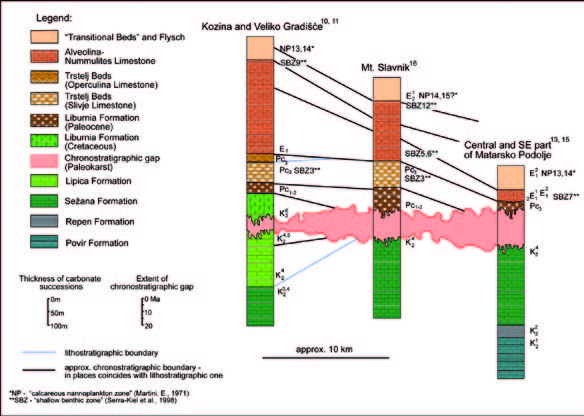Upper Cretaceous to Paleogene Forbulge Unconformity Associated With Foreland Basin Evolution (Kras, Matarsko Podolje and Istria; SW Slovenia and NW Croatia)
DOI:
https://doi.org/10.3986/ac.v36i1.213Povzetek
A regional unconformity separates the Cretaceous passive margin shallow-marine carbonate sequence of Adriatic Carbonate Platform from the Upper Cretaceous and/or Paleogene shallow-marine sequences of synorogenic carbonate platform in southwestern Slovenia and Istria (a part of southwestern Slovenia and northwestern Croatia). The unconformity is expressed by irregular paleokarstic surface, locally marked by bauxite deposits. Distinctive subsurface paleokarstic features occur below the surface (e.g. filled phreatic caves, spongework horizons…).
The age of the limestones that immediately underlie the unconformity and the extent of the chronostratigraphic gap in southwestern Slovenia and Istria systematically increase from northeast towards southwest, while the age of the overlying limestones decreases in this direction. Similarly, the deposits of synorogenic carbonate platform, pelagic marls and flysch (i.e. underfilled trinity), deposits typical of underfilled peripheral foreland basin, are also diachronous over the area and had been advancing from northeast towards southwest from Campanian to Eocene. Systematic trends of isochrones of the carbonate rocks that immediately under- and overlie the paleokarstic surface, and consequently, of the extent of the chronostratigraphic gap can be explained mainly by the evolution and topography of peripheral foreland bulge (the forebulge). The advancing flexural foreland profile was the result of vertical loading of the foreland lithospheric plate (Adria microplate) by the evolving orogenic wedge. Because of syn- and post-orogenic tectonic processes, and time discrepancy between adjacent foreland basin deposits and tectonic (“orogenic”) phases it is difficult to define the exact tectonic phase responsible for the evolution of the foreland complex. According to position and migration of the subaerially exposed forebulge, distribution of the foreland related macrofacies and orientation of tectonic structures, especially of Dinaric nappes, and Dinaric mountain chain I suggest that the foreland basin complex in western Slovenia and Istria was formed during mesoalpine (“Dinaric”) tectonic phase due to oblique collision between Austroalpine terrane/Tisia microplate and Adria microplate when probably also a segmentation of the foreland plate (Adria microplate) occurred.
Prenosi

Prenosi
Objavljeno
Kako citirati
Številka
Rubrike
Licenca
Avtorji jamčijo, da je delo njihova avtorska stvaritev, da v njem niso kršene avtorske pravice tretjih oseb ali kake druge pravice. V primeru zahtevkov tretjih oseb se avtorji zavezujejo, da bodo varovali interese založnika ter da bodo povrnili morebitno škodo.
Podrobneje v rubriki: Prispevki




